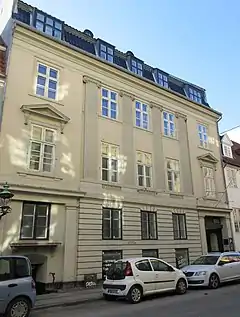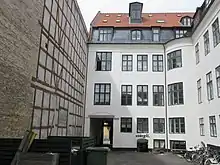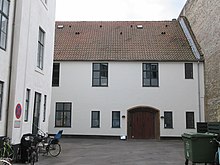Ny Kongensgade 9
Ny Kongensgade 0 is a Neoclassical property located in the small Frederiksholm Neighborhood of central Copenhagen, Denmark. It consists of a three-storey building with Mansard roof from 1804 towards the street, a six-bay side wing along the eastern margin of a courtyard and an older two-storey building on its rear. The building from 1804 with its six-bay side wing, was listed in the Danish registry of protected buildings and places in 1904. The low building in the courtyard is not listed.
| Ny Kongensgade 9 | |
|---|---|
 | |

| |
| General information | |
| Location | Copenhagen |
| Country | Denmark |
| Coordinates | 55°40′25.46″N 12°34′35.72″E |
| Completed | 1804 |
History
Ny Kongensgade 9 was constructed in 1804 for Christian Nicolai Lautrup (1764 - 1817). He worked as a senior clerk for Den Almindelige Enkekasse.[1] His son by the same name was later director of Den Almindelige Enkekasse. Another son, Jørgen Hjort Lautrup, would become Bishop of Lolland-Falster.[2]
Notable 19th century residents include the politician Frederik Moltke (1811–1813 and again 1825–1830), actor and stage director Frederik Schwarz (1822), engineer Ludwig A. Colding (mid 1840s), politician Iver Johan Unsgaard (1857–1858), politician Ludvig Nicolaus von Scheele (1first floor, ?–1874), art historian Julius Lange (mid 1870s), painter Carl Bloch (first floor, 1879–1881) and painter-and-illustrator Lorenz Frølich (1899 – c. 1904).[3]
Sophus Falck was a resident in the building from 1910 and opened the first Falck station in a building in the courtyard (No. 9C). The company had until then been based at No. 15 in the same street. Falck left the premises just five years later when the transition from horse-drawn vehicles to automobiles made the location unpractical. The building in the courtyard was then left empty for a while. It was in 1941 taken over by the Danish chapter of the Templars of Honor and Temperance. They occupied the building until 2015.[4]
Architecture


Ny Kongensgade 9 consists of three storeys over a raised cellar and is finished by a Mansard roof with a chimney at its eastern gable. The facade is dressed in a pale sand colour over a black-oaunted plinth. The roof is towards the street clad with vlack-glazed tiles and accentuated by a dentilized cornice. The three central bays are accentuated by a median risalit with four giant order Ionic pilasters on the upper flors. The pilasters are supported by a band with acanthus decoations, the latter of which were added in 1854. Between the pilasters runs a sill cornice under the windows on the second floor. The two outer bays are wider than the three central ones. Their windows are accentuated by window frames and sills in sandstone and the windows of the beletage are in addition to this topped by pediment. The outer bays of the ground floor are vlankedby smooth pilasters. The one to the left (west) is an arch-headed gate. The one to the right (east) features a window and a cellar entrance with a small sandstone canopy. A sux-bay side wing extends from the rear side of the building. It adjoins another building which is again connected to a two-storey building at the bottom of the courtyard (No. 9C). The western margin is defined by a half-timbered wall of the side wintg at No. 11.[5]
Today
The building is rented out as office space. The low building at No. 9C is rented out as a venue for parties, meetings and other events.[4]
References
- "Ny Kongensgade 9a-c" (in Danish). indenforvoldene.dk. Retrieved 21 December 2020.
- "Christian Nicolai Lautrup" (in Danish). indenforvoldene.dk. Retrieved 21 December 2020.
- "Lidt historie om FalckLautrup" (in Danish). Falck. Retrieved 21 December 2020.
- "Tempelriddersalen" (in Danish). Venue. Retrieved 21 December 2020.
- "Sag: Ny Kongensgade 9" (in Danish). Kulturstyrelsen. Retrieved 21 December 2020.